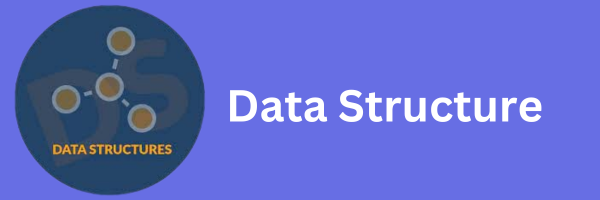WhatsApp
9308654075
Courses
- Web Development
- Data Analytics
- Data Science with AI
- Cyber Security
- Python
- Django
- C Language
- C++
- Java Training
- Data Structure
- Algorithm
- Front-end Development
- JavaScript, jQuery & Ajax
- React.js
- Node.js & Express.js
- MySQL
- SQL
- PL/SQL
- Oracle
- MongoDb
- SQLITE
- ADCAT
- ADCA
- DCA
- Tally Prime
- Advance Excel
- COA
- ADOA
- GST
- TAT
- TDS & Payroll

Data Structure
A data structure is a particular way of organising data in a computer so that it can be used effectively. The idea is to reduce the space and time complexities of different tasks. Data structures provide a means to manage large amounts of data efficiently for uses such as large databases and internet indexing services. Usually, efficient data structures are key to designing efficient algorithms. Some formal design methods and programming languages emphasize data structures, rather than algorithms, as the key organising factor in software design. Data structures can be used to organise the storage and retrieval of information stored in both main memory and secondary memory.
| Course Name | Date & Time | Take Demos |
|---|---|---|
| Core Java | 03/06/2024 | View Details |
| User Interface(UI) | 03/06/2024 | View Details |
| React.js | Starting Soon... | View Details |
| MySQL | Starting Soon... | View Details |
| ADCAT | Starting Soon... | View Details |
Where it is used?
Data Structure is mostly used in the following application:
- Array - Plagiarism detection, spam email detection, search engine, spell checker.
- Linked List - History of visited pages, switching between application and program in the OS, social media content "feeds".
- Hash Table – used for fast data lookup – symbol table for compilers, database indexing, caches, Unique data representation.
- Stack – undo\redo operation in word processors, Expression evaluation and syntax parsing, many virtual machines like JVM are stack oriented, forward/backward surfing in the browser, message logs, call logs, YouTube downloads, scratch cards earned after Gpay transactions.
- Queues – Job scheduling in OS, data packets in communication, sending an email, uploading and downloading photos, handling website traffic, CPU scheduling.
- Tree - XML parcel, decision based algorithm in Machine Learning, database indexing, computer graphics, code compression, evaluate an expression, routing table, data analysis and data mining, dictionary application, auto complete feature in searching.
- Graphs – Connections/relations in social networking sites, Google Maps, GPS navigation system, Facebook to suggest mutual friends.
WHY REPL?
- Life time validity (enroll one time and revise many times)
- Interaction with the best faculty and Industry Experts
- Small Batches to focus on each student
- We focus on both theoretical and practical approaches in a parallel way.
- You will be given the opportunity to work on a live project.
- Outdoor activities to boost your confidence.
- Presentation in class by the students.
Our Key Features:
- Good Quality Material Notes
- Smart Classes Available
- Online Test
- Chapter wise Assignments
- Offline And Online Classes
- Recorded class on Rays App
- Eminent faculties of the IT Industry( Amazon, Wal-Mart, Oracle, Microsoft..)
- Fully AC and Wi-Fi Campus.
Syllabus
- About structure
- Defining structure
- Accessing structure element
- Use of operator sizeof
- Type casting
- Dynamic memory allocation by using inbuilt function malloc() and calloc()
- Differences between malloc() and calloc()
- Use of realloc()
- Deallocation by using inbuilt function free()
- About Linked list
- Types of Linked List
- (i) Linear or single or one-way linked list
- (ii) Double or two way linked list
- Linear or single or one way linked list
- Implementation / Representation of single linked list
- Adding new node to linked list
- (a) Adding at beginning
- (b) Adding at ending
- (c) Adding before specified position
- (d) Adding after specified position
- Deleting a node from linked list
- (a) Deleting beginning node
- (b) Deleting end node
- (c) Deleting specified position node
- Searching a node in linked list
- Double or two-way linked list
- Implementation / Representation of single linked list
- Adding new node to linked list
- (a) Adding at beginning
- (b) Adding at ending
- (c) Adding before specified position
- (d) Adding after specified position
- Deleting a node from linked list
- (a) Deleting beginning node
- (b) Deleting end node
- (c) Deleting specified position node
- Searching a node in linked list
- Some more linked list
- Circular linked list
- (a) Singly circular linked list
- (b) Doubly circular linked list
- Header linked list
- (a) Singly header linked list
- (b) Doubly header linked list
- Circular linked list
- Application of linked list
- Concatenation of two linked list
- Polynomial
- (a) Representation of polynomial
- (b) Addition of polynomial
- (c) Multiplication of two polynomial
- Sparse matrics
- (a) Representation of sparse matrics
- (a) By using array
- (b) By using linked list
- (b) Addition of two sparse matrics
- (a) Representation of sparse matrics
- Introduction to Stack
- Operation on Stack
- Stack Implementation
- By Using Array
- By Using Linked List
- Stack Application in computer field
- Representation two stacks
- Arithmetical Expression
- Different form of an expression
- (a) Infix form
- (b) Prefix form or Polish form
- (c) Postfix form or Reverse Polish form
- Conversion one form to another form
- (a) Conversion from infix to prefix and postfix form
- (b) Conversion from postfix to infix and prefix form
- (c) Conversion from prefix to infix and postfix form
- Algorithm to evaluate a postfix expression
- Introduction to Queue
- Operation on Queue
- Queue Implementation
- By Using Array
- By Using Linked List
- Types of Queue
- Circular Queue
- Dequeue
- Priority Queue
- Introduction to Tree
- Important properties of tree
- Some tree terminology
- Types of tree
- Binary Tree
- (a) Strictly binary tree or two tree
- (b) Complete binary tree or full binary tree
- Binary search tree (BST)
- Expression tree
- AVL tree or Height Balance tree
- Threaded binary tree
- B – tree
- Binary Tree
- Binary Tree
- Representation of binary tree
- (a) Array or Sequential representation
- (b) Linked list representation
- Traversal of binary tree
- (a) Inorder traversal
- (b) Preorder traversal
- (c) Postorder traversal
- (d) Level-by-Level traversal
- Representation of binary tree
- Non-recursive traversal of binary tree
- (a) Inorder traversal
- (b) Preorder traversal
- (c) Postorder traversal
- Binary search tree (BST)
- Representation of BST
- (a) Array or sequential representation
- (b) Linked list representation
- Search in BST
- Insertion into BST
- Deletion from BST
- Representation of BST
- Expression tree
- Representation of expression tree
- Traversal of expression tree
- (a) Inorder traversal
- (b) Preorder traversal
- (c) Postorder traversal
- AVL tree or Height balance tree
- Insertion of a node into an AVL tree
- Deletion from an AVL tree
- B-Tree
- Drawing of a B-Tree
- Deletion of B-Tree
- Introduction to Graph
- Graph terminology
- Types of Graph
- Representation of Graph
- (a) Adjacency matrix
- (b) Adjacency list
- Graph Traversals
- (a) Breadth first search (BFS)
- (b) Depth first search (DFS)
- Transitive clouser
- Program to compute transitive clouser
- Shortest path problem
- About Minimal spanning tree (MST)
- Introduction to MST
- Construction of MST
- (a) Krushkal’s method/algorithm
- (b) Prim’s method/algorithm
- Searching
- (a) Sequential searching
- (b) Binary searching
- Sorting
- (a) Bubble sort (b) Insertion sort (c) Quick sort (d) Merge sort (e) Heap sort (f) selection sort (g) shell sort (h) Radix sort
- Types of Graph
- Representation of Graph
- (a) Adjacency matrix
- (b) Adjacency list
- Graph Traversals
- (a) Breadth first search (BFS)
- (b) Depth first search (DFS)
- Transitive clouser
- Program to compute transitive clouser
- Shortest path problem
- About Minimal spanning tree (MST)
- Introduction to MST
- Construction of MST
- (a) Krushkal’s method/algorithm
- (b) Prim’s method/algorithm
Recent Posts



Request A Demo!
|
|
|
|
|
|
|
|
Sign In!
|
|
|
|
